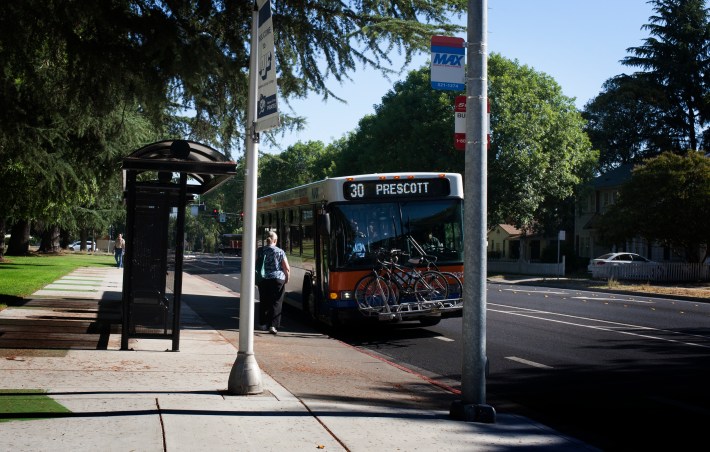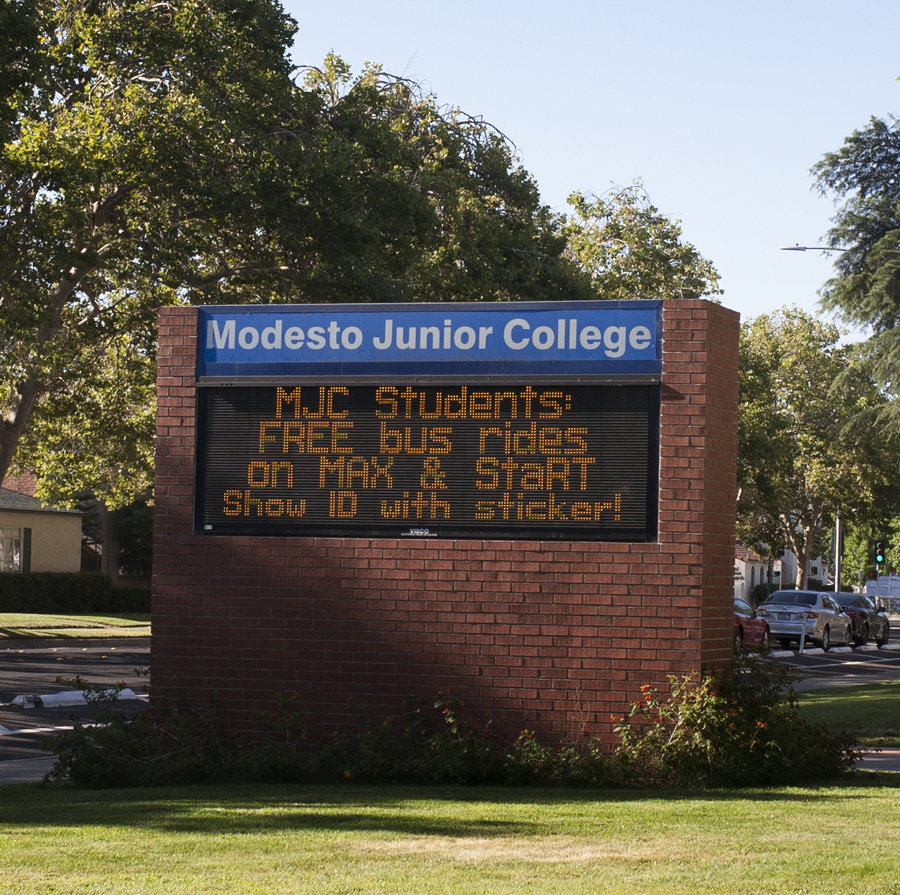Modesto Junior College (MJC) is joining a growing list of institutions that are partnering with transit to ease the financial burden of getting an education. As of July 1, all MJC students can ride city and county transit systems for free.
Linda Hoile, public information officer for the college, said the arrangement began after student focus groups revealed that “a lack of reliable transportation was a major obstacle for some of our low-income students.”
Under the agreement, the college will pay the city of Modesto $100,000 per year for students to ride the Modesto Area Express (MAX) transit system, and Stanislaus County $60,000 per year for use of the Stanislaus Regional Transit (StaRT) system. The college is paying for this program through statewide funding meant to reduce the achievement gap among certain student groups, such as low-income and disabled students.
At the end of the first year the college, city, and county will review ridership data and evaluate the program. Any changes negotiated would not take effect for another year - until July 1, 2019, at the earliest.
An effort to create a statewide funding source specifically for low-income youth transit passes is crawling through the legislative process, but local schools are not waiting for that to happen - and MJC is not alone in trying to find ways to make transit use affordable for students in the face of rising college costs. Pasadena City College, Rio Hondo College, and the Los Rios Community College District are just a few of the community colleges that have implemented student transit pass programs. In Turlock, fourteen miles south of Modesto, the city entered into a multi-year partnership with California State University Stanislaus’s Associated Students Incorporated (ASI) to give students unlimited use of that city’s fixed-route bus system.
Irving Cornejo Calderon, a student at MJC, said the MAX bus is his primary mode of transportation. He doesn’t know how to drive and relies on his parents or Lyft to take him where he needs to go when he's not on the bus.
“I take the bus pretty much all weekdays and sometimes on Saturdays,” he said. “I currently need to come to MJC West three days a week - sometimes a full week when I need to do outside lab work.”
The multimedia design major said the free transit program would help him and a lot of students out financially, especially because he is aware that the city council is considering raising the fares on the MAX. He used to pay about $30 every month to ride the bus, until the new partnership launched a few days ago.
Calderon says he has noticed a difference in the number of people riding the MAX. “I used the bus this morning,” he said, “and I did personally see that there was more activity than in past weeks.” It may be a bit early to speculate on the program's effect on ridership, but it should be noted that MJC's summer session has been in full swing since May.
Before the partnership, full time college students paid $1.25 for one bus ride, $3.25 for an all-day pass, and $38 for a monthly pass on the MAX. Out-of-town students paid $1.60, $3.25, and $46 for the same fares on StaRT.
But now, to ride the bus all students have to do is show their college ID card, which will have a semester sticker provided by MJC proving that they are currently enrolled. The student pass is only available on fixed-route service, however, and excludes both systems’ commuter buses as well as StaRT’s dial-a-ride, shuttle, paratransit, and medivan services.
Adam Barth, transit manager for the MAX, said the change would benefit both the college and the city. The MAX provided 3.1 million trips on twenty routes including the commuter routes in 2016, so it is a well-utilized system, he said. He estimates that about 98,000 of the bus rides in 2016 were taken by MJC students.
“We are hoping to get more frequency from riders (with this partnership),” Barth said.

A large portion of Modesto Junior College students live in communities within Stanislaus County but outside Modesto, and many of them will benefit from the agreement with StaRT. Annette Borrelli, staff services coordinator for StaRT, said she doesn’t have any recent data on ridership, but that overall it has decreased in recent years. She hopes the partnership will create some frequent riders once students realize how convenient it is to take the bus.
Borelli said there are four bus lines that make stops at MJC, including those that go to rural communities like Grayson and Westley. Additionally, many of these lines run late into the evening, serving students who have late classes or need more time to get home, she said.
Free transit is just one of the transportation perks available to Modesto Junior College students. The college also operates a shuttle between the east and west campuses, and the city of Modesto just completed a 2.2-mile protected bike path between the two campuses so that students and faculty can commute safely by bike.
Community colleges including Modesto Junior College continue to be much more affordable than the state’s four-year institutions. But a survey conducted by the California Student Aid Commission found that associated costs can stack up quickly, and that California college students can expect to pay up to $1,000 per year on transportation alone. At MJC, a parking permit is priced at $30 for the fall and spring semesters, $15 for the summer session, and $2 per day. As a result, said Hoile, some students look for on-street parking in nearby neighborhoods, rather than pay for a parking permit.
Approximately 93 percent of the students that enrolled at MJC in fall 2016 were considered low-income, according to Hoile. She said providing free bus rides removes “lack of transportation” as an obstacle for many community members to access the educational opportunities available at MJC.
“Students who don’t have a car, or cannot afford gas, now have a free, alternative way to get to class,” she said, “and also to work.”






